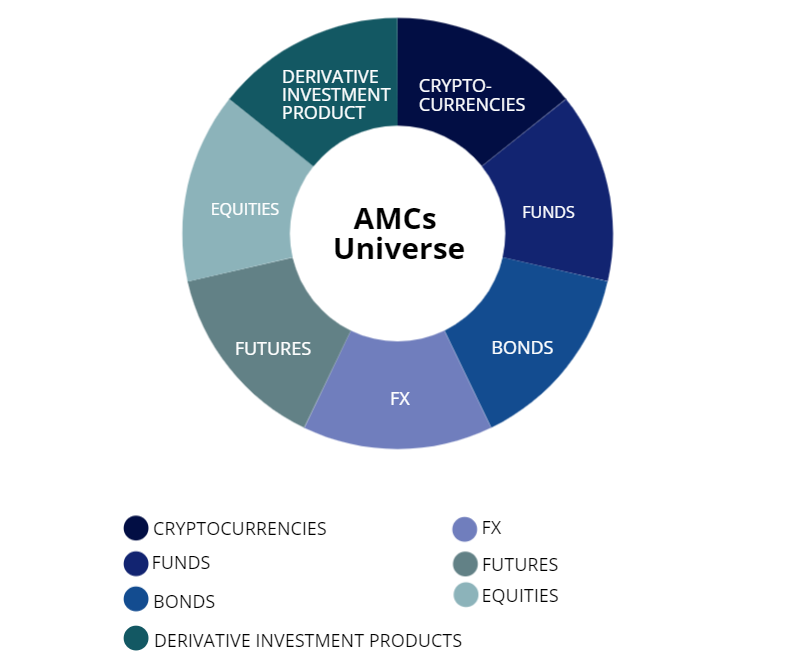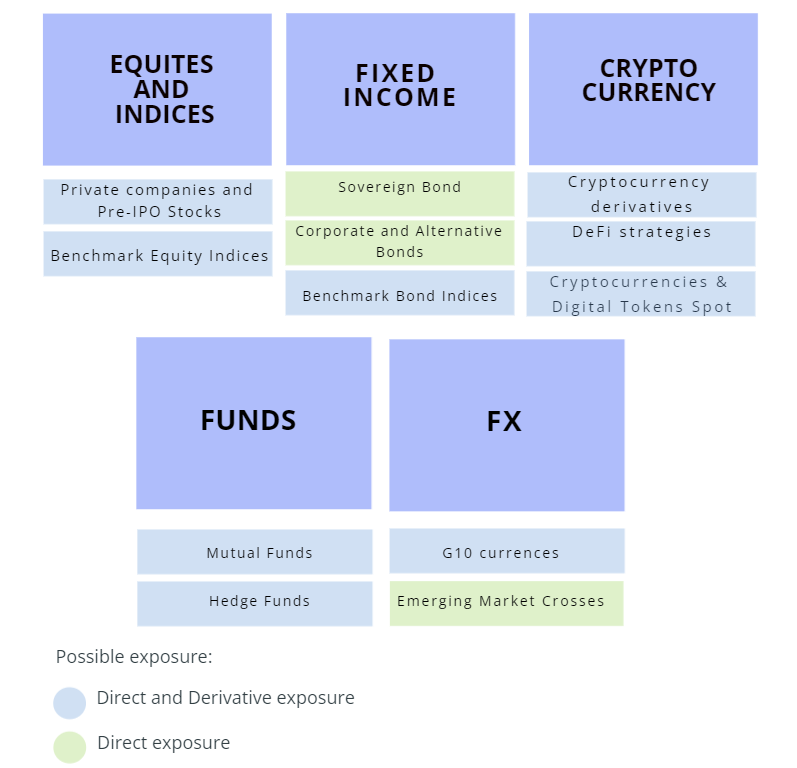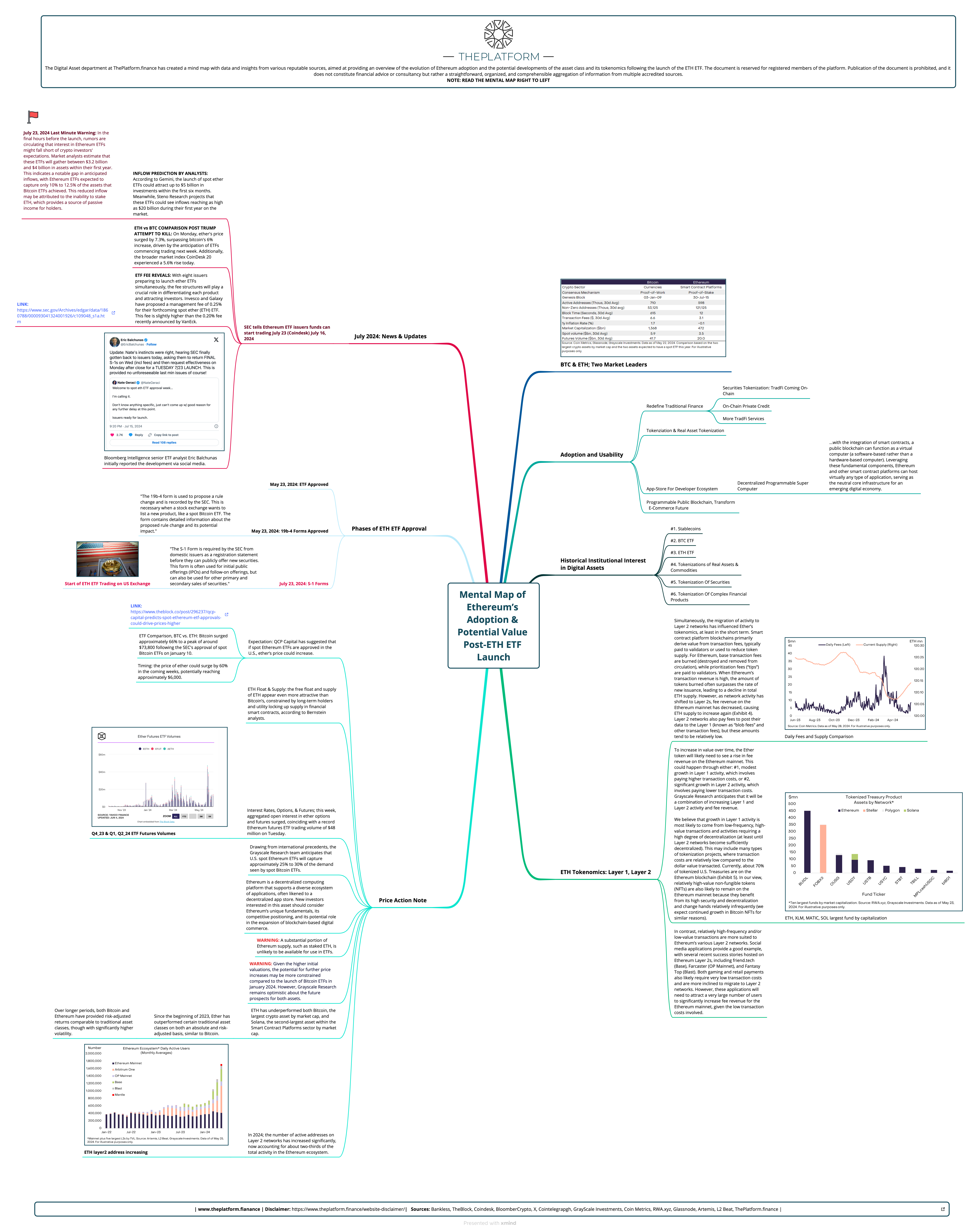Introduction
“Actively Managed Certificates” (“AMC”) are structured financial products, more precisely Tracker Certificates, whose underlying asset is managed on a discretionary or algorithmic basis during the term of the product in accordance with a specific investment strategy. The issuer synthetically implements its investment strategy or an investment strategy proposed by a third party (the “Index Sponsor”), whereby the Index Sponsor may, at its discretion, compose and restructure the underlying asset in accordance with the framework of the investment strategy. The performance of an AMC therefore depends on the Index Sponsor’s ability to (synthetically) implement the investment strategy. Investors are informed transparently under the product documentation on the investment strategy, its implementation by the Index Sponsor and the costs associated with the AMC.
The following paper will probe deep into the asset classes that can be used as underlying and the corresponding management of the just mentioned investment strategy.
Underlying Universe
When defining the Investment Universe and Strategy, the Index Sponsor has the opportunity to focus on a single asset class or a wide diversified portfolio including multiple types of underlying. Combining multiple asset classes in strategy will give the freedom to construct an Index (which represents a hypothetical portfolio) just the way the Index Sponsor wants.
A wide range of underlyings are covered with the possibility to combine them across asset classes. Furthermore, AMCs can, depending on the pre-defined Investment Universe and Strategy, invest in structured products and other derivatives such as Forwards, Swaps, OTCs and listed Options.
The Index Sponsors can use leverage as well as implement short strategies (provided that the elected underlying is liquid enough to borrow and is not subject to any short selling restrictions).
It is also possible to predefine a Stop Loss expressed as a percentage of the Initial Fixing of the AMC (mandatory in the case of an AMC with leverage effect). The Stop Loss is observed on the AMC value during the lifetime of the product and is triggered if the AMC value falls below the predefined level.
Therefore, the Index Sponsor can choose from any asset classes mentioned in the figure above. But let’s explore each of these possibilities in more detail.

Source: Leonteq
Equities and Indices
- Private companies and Pre-IPO Stocks: it is typically referred to as shareholders’ equity, represents the amount of money that would be returned to a company’s shareholders if all of the assets were liquidated and all of the company’s debt was paid off in the case of liquidation. Thus, equity represents the shareholders’ stake in the company, identified on a company’s balance sheet. The “AMCs” have proved to be very useful tools to allow access to stocks of private companies that are not always easily accessible, such as pre-ipo stocks, even with investment sizes that are not too large.
- Benchmark Equity Indices: it measures the price performance of a basket of securities using a standardized metric and methodology. Indexes typically measure the performance of a basket of securities intended to replicate a certain area of the market. These could be a broad-based index that captures the entire market, such as the Standard & Poor’s 500 Index or Dow Jones Industrial Average (DJIA), or more specialized such as indexes that track a particular industry or segment. AMCs can be used to track equity indices, in particular, to dynamically manage portfolios of different indices.
Fixed Income
- Sovereign Bonds: A sovereign bond is a debt security issued by a national government to raise money for financing government programs, paying down old debt, paying interest on current debt, and any other government spending needs. Sovereign bonds can be denominated in a foreign currency or the government’s domestic currency. Sovereign bonds are a source of government financing alongside tax revenue. The use of AMCs allows multiple investors access to Sovereign Bonds typically accessible only to Institutions willing to invest in huge sizes.
- Benchmark Bond Indices: A benchmark bond is a bond that provides a standard against which the performance of other bonds can be measured. Government bonds are almost always used as benchmark bonds such as on-the-run U.S. Treasuries. AMCs can be used to track bond indices, in particular, to dynamically manage portfolios of different indices.
- Corporate and Alternative Bonds: A corporate bond is a type of debt security that is issued by a firm and sold to investors. The company gets the capital it needs and in return, the investor is paid a pre-established number of interest payments at either a fixed or variable interest rate. When the bond expires, or “reaches maturity,” the payments cease and the original investment is returned. The backing for the bond is generally the ability of the company to repay, which depends on its prospects for future revenues and profitability. In some cases, the company’s physical assets may be used as collateral. The use of AMCs allows multiple investors, even with small sizes, to access alternative and exotic corporate bonds. These bonds can be purchased through the active certificate in a private placement, through direct agreements with the issuing companies. They give access to truly alternative investment opportunities, although not always liquid.
Cryptocurrencies
- Cryptocurrencies and Digital Tokens (Altcoin) Spot: A spot market in cryptocurrency is a platform, particularly available on exchanges, where you can perform real-time trades. Transactions are efficiently settled and orders are filled in a timely manner. As a buyer, you can trade multiple currencies in specific pairs (like BTC, ETH, BNB or even FIAT). Moreover, these spot markets have three major components: sellers, buyers, and an order book. Spot markets exist in different forms, such as over-the-counter trades (OTC) and third-party exchanges. Notably, over-the-counter trades involve only sellers and buyers with no interference from brokers. In contrast, third-party exchanges work as brokers or intermediaries between sellers and buyers. AMCs also allow Institutional, Qualified and Professional investors access to these unregulated markets, through a regulated framework (provided by the AMC). They also allow access to the investment avoiding complex technical procedures deriving from the need to open accounts on different and non-standard technological platforms.
- Cryptocurrency derivatives: Actively Managed Structured financial products can be used to replicate advanced strategies on crypto assets and derivatives on cryptocurrencies (Bitcoin, Ethereum, Ripple, Bitcoin Cash) allowing through a regulated instrument, the implementation in portfolios of hedge or cash and carry strategies also on digital assets.
- DeFi (Decentralized Finance) strategies: The world of actively managed structured products in the crypto space continues to gain ground, allowing investors of various risk profiles to participate in the DeFi ecosystem. Through the AMCs it is possible to access Decentralized Finance protocols, and invest in the strategies proposed by DeFi landing and borrowing platforms.
Funds
- Mutual Funds: Collective investment scheme including without limitation money market funds, equity funds, bond market funds and real estate funds. AMCs are very useful in creating dynamic mutual funds portfolios. Portfolios of these types are very similar to the more well-known Umbrella Funds, but unlike these, the AMCs are less expensive and more flexible in structuring and management.
- Hedge Funds: A hedge fund is a limited partnership of private investors whose money is managed by professional fund managers who use a wide range of strategies, including leveraging or trading of non-traditional assets, to earn above-average investment returns. Hedge fund investment is often considered a risky alternative choice and usually requires a high minimum capital or net worth, often targeting wealthy clients. For the hedge fund market, AMCs are valuable allies. They allow the fund’s strategies to be distributed across multiple jurisdictions without the need for the Hedge Fund to open a regulated branch (the AMC itself is regulated in that jurisdiction). They also make it possible to raise capital from multiple investors, with smaller investment sizes than the “minimum ticket” established by the fund’s policy. The final investor of the hedge fund will be the AMC, not the investors adhering to it.
FX
- G10 Currencies: The G10 currencies are ten of the most heavily traded currencies in the world, which are also ten of the world’s most liquid currencies. Traders regularly buy and sell them in an open market with minimal impact on their own international exchange rates. The G10 currencies are: Australian dollar (AUD), Canadian dollar (CAD), Euro (EUR), Japanese yen (JPY), New Zealand dollar (NZD), Norwegian krone (NOK), Pound sterling (GBP), Swedish krona (SEK), Swiss franc (CHF), United States dollar (USD). AMCs allow effective access to discretionary and algorithmic trading strategies on currencies faithfully replicating the choices of the trading team.
- Emerging Market Crosses: Possibility to invest in Emerging Market gaining a premium, which is the compensation that investors require for assuming the risk that the respective EM currency may experience a decline in its value against the numeraire currency (i.e., the U.S. dollar) over the term of the forward contract. AMCs allow effective access to discretionary and algorithmic trading strategies on emerging currencies faithfully replicating the choices of the trading team.
OTC Products

Source: Leonteq
As shown in the figure above, the asset classes underlying in AMC can have either a direct or derivative exposure, or both. In fact, Actively Managed Certificates can be composed of unfunded over the counter (OTC) structured product in different formats (Option or Swap) for investors willing to optimize the cash allocation of their portfolio. In general, OTC transactions require a contractual relationship which is based on an ISDA / CSA agreement between the two counterparties. Within an AMC, no such agreement is required as the Index components will be used as margin collateral.
Investment Style
Index Sponsors can choose from any of the below Investment Styles:
- Discretionary: in this case, the Index Sponsor or a third-party representative is responsible for the asset allocation within the investment strategy. These allocations can be made at a regular interval or on ad hoc basis.
- Algorithm (Quantitative Investment Strategies (QIS)): this is a statistical and financial rules-based approach governed by algorithms agreed prior to the implementation. The portfolio allocation and the lifecycle will be streamlined based on the algorithm of the QIS.
Overlay
Index Sponsors can choose from any of the below Overlay:
- FX Hedge: in case the Index Strategy requires an FX Hedge, the Index Sponsor can hedge the FX exposure by sending ad-hoc instructions. The Index Sponsor may also instruct on an automatic periodic rolling position using FX forwards.
- Options and Exotic Derivatives: in case the Index Strategy consists of Options or Exotic Derivatives Overlay, this provide a non-linear exposure to the underlying assets. This type of overlay may be used for portfolio hedging purpose or to gain leveraged exposure.
Risk Considerations
The AMC (Product) provides exposure to an actively managed Index advised by the Index Sponsor. The Index Sponsor has a significant scope of discretion in terms of the Index composition and will determine the initial composition of the Index and subsequent adjustments thereof. The performance of the Index and hence the Product depends, inter alia, on the quality of the Index Sponsor’s investment decisions. Investors need to conduct their own due diligence with respect to the Index Sponsor.
In addition, investors might be exposed to the following risks:
- Foreign Exchange Risk;
- Interest Rate Risk;
- Credit Risk, that is the ability of the ability of the Issuer to meet its obligations under the Product will depend on, amongst other things, the receipt by it of payments of interest and/or principal (or other) from the Components;
- Early Termination Risk, as the Issuer may call the Product in accordance with the provisions as set forth in the Product documentation;
- Illiquidity Risk, as one or more of the Components might be or become illiquid over the life time of the Product.




